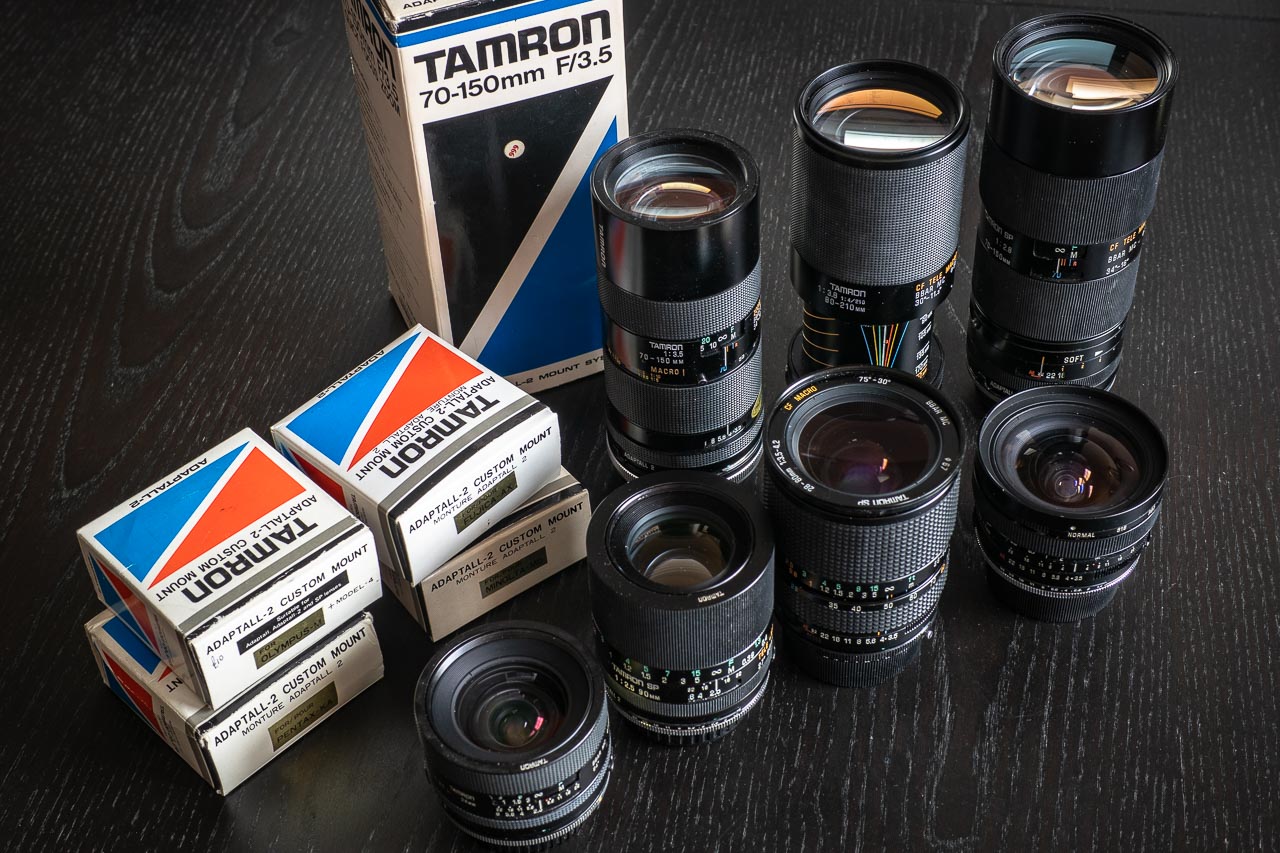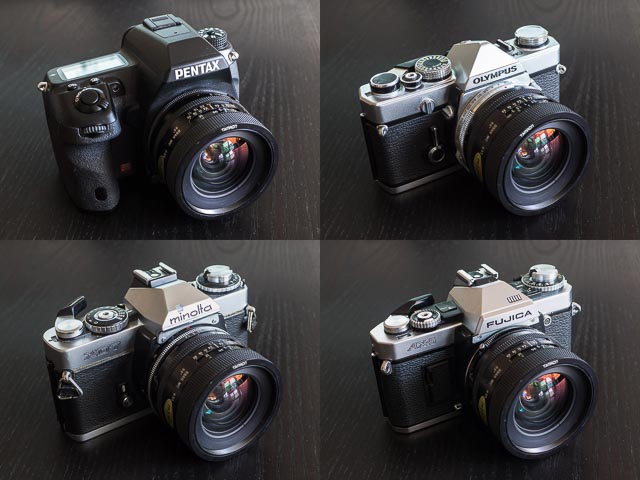Tamron Adaptall 2 lenses

Top row (left to right):
Tamron 70-150mm f/3.5 (02A)
Tamron 80-210mm f/3.8-4 (103A)
Tamron SP 70-150mm f/2.8 Soft (51A) (sample photos)
Bottom row (left to right):
Tamron 24mm f/2.5 (01B) (sample photos)
Tamron SP 90mm f/2.5 Macro (52B) (sample photos)
Tamron SP 28-80mm f/3.5-4.2 (27A)
Tamron SP 17mm f/3.5 (51B) (sample photos)
Not illustrated above:
Tamron 135mm f/2.5 (03B) (sample photos)
Introduction to Tamron Adaptall 2 lenses
If you have a collection of 35mm manual focus SLR cameras from the 1970s and 80s with a variety of different mounts, buying a complete set of lenses for each lens mount rapidly becomes an expensive process even if each individual lens doesn't cost very much.
 But there is an answer to this problem: Tamron Adaptall 2 lenses.
But there is an answer to this problem: Tamron Adaptall 2 lenses.
Today Tamron make fixed mount lenses like everyone else… but back in the manual focus era they made a range of lenses with interchangeable mounts (which Tamron called 'custom mounts'). And these custom mounts weren't like the dumb mount adapters you might be using to use old lenses on your digital compact system camera. They integrated completely with the lens to create something that operated (for the most part!) just like a fixed mount lens. And it's not just the custom mount system that distinguishes Tamron lenses from their competitors, many of them are great optically too. In fact one of these lenses is one of my all-time favourites any type: the Tamron SP 90mm f/2.5 Macro (52B). If I had to recommend just one Tamron lens, that would be the one!
The Tamron custom mount story began when they launched the Adapt-A-Matic system in 1969. As lens mounts become more complex they introduced the Adaptall system in 1973 and finally the Adaptall 2 system in 1979. Lenses for the Adaptall 2 system were made for an incredible 27 years, right up until 2006!
Adaptall 2 mounts were masterpieces of engineering that no other manufacturer was ever able to replicate. Put the correct Adaptall 2 mount on your lenses and all the automatic exposure modes (including shutter speed priority and fully automatic programme modes) and metering facilities (including open aperture metering) of your camera worked just as if you were using a fixed mount lens.
But as camera technology advanced even further, and ever more communication between lens and camera was needed, even Tamron's genius engineers met their limits. In particular autofocus SLR cameras defeated their engineering ingenuity, and Tamron never managed to create an interchangeable mount system for these cameras.
Tamron Adaptall 2 lenses were divided into 2 ranges: a range of standard consumer level lenses known simply as "Adaptall 2" lenses, and a range of more professional and specialised lenses known as "Adaptall 2 SP" lenses. Tamron never expanded that "SP" acronym, but Special Performance seems like a reasonable guess!
 I've been meaning to build a small collection of Tamron Adaptall 2 lenses for my collection of 1970s and 80s SLRs for a while, and recently I've been making good on this ambition. Above you can see the lovely Tamron 24mm f/2.5 lens mounted on 4 different cameras. 3 of these 4 camera offer a multitude of automatic exposure modes and with the correct Adaptall 2 mount all these automatic modes are fully supported, even on my modern Pentax K-3ii DSLR (though they are still manual focus of course!)
I've been meaning to build a small collection of Tamron Adaptall 2 lenses for my collection of 1970s and 80s SLRs for a while, and recently I've been making good on this ambition. Above you can see the lovely Tamron 24mm f/2.5 lens mounted on 4 different cameras. 3 of these 4 camera offer a multitude of automatic exposure modes and with the correct Adaptall 2 mount all these automatic modes are fully supported, even on my modern Pentax K-3ii DSLR (though they are still manual focus of course!)
 There is one slight catch with the Pentax DSLRs though… you need the Pentax K-A mount, not just the ordinary Pentax K mount, and these command quite a premium. They will cost you £35-50 on eBay, compared to £5-15 for a standard Pentax K mount. They also have a deserved reputation for being being rather temperamental, so my advice is to spend a little extra to buy from a reputable vendor who is prepared to guarantee full functionality.
There is one slight catch with the Pentax DSLRs though… you need the Pentax K-A mount, not just the ordinary Pentax K mount, and these command quite a premium. They will cost you £35-50 on eBay, compared to £5-15 for a standard Pentax K mount. They also have a deserved reputation for being being rather temperamental, so my advice is to spend a little extra to buy from a reputable vendor who is prepared to guarantee full functionality.
I have also found that my K-3ii sometimes has a little difficulty displaying the correct F number for apertures between the full stops. But in practice this doesn't really matter as my K-3ii metered perfectly regardless of the aperture setting.
But this is one of Tamron's first generation of Adaptall 2 lenses introduced in 1979. So you have to cut a 40+ year old lens a little slack! I have to say that it always gives me a bit of a thrill to give a beautiful piece of classic glass a new lease of life.
Although there were many basic common-or-garden consumer zoom lenses in the Adaptall 2 range, the best Tamron lenses have excellent reputations, particularly the SP lenses. Adaptall 2 lenses also had a very distinctive design and, at least in the case of the earliest designs, high quality metal construction. Also, when it comes to the fixed focal-length lenses, while most competing designs have maximum apertures f/3.5 or f/2.8, the equivalent Tamron lenses often have a slightly faster maximum aperture of f/2.5. Not enough to make a big difference perhaps, but still a nice little bonus!
Links
adaptall-2.com
Because Tamron Adaptall 2 lenses were made over an incredible 27 year period from 1979 to 2006 it's understandable that the range of lenses is large and sometimes rather confusing. Many of the lenses were made in several versions as the designs were updated both cosmetically and optically over the years. adaptall-2.com of the best sites to get more information about Adaptall 2 lenses and also has surprisingly comprehensive information on the earlier Adapt-A-Matic and original Adaptall lenses. But it is missing information on a few of the last Adaptall 2 lenses from the late 1990s and early 2000s.
Tamron Adaptall lenses on the Pentax Forums website
The Pentax Forums section on Adaptall lenses has information on the lenses missing from adaptall-2.com such as the 28-200mm, 35-105mm f/2.8 SP and 28-105mm f/2.8 SP lenses.
Instruction manuals for Tamron custom mounts
Covers Adapt-A-Matic, Adaptall and Adaptall 2 lenses.